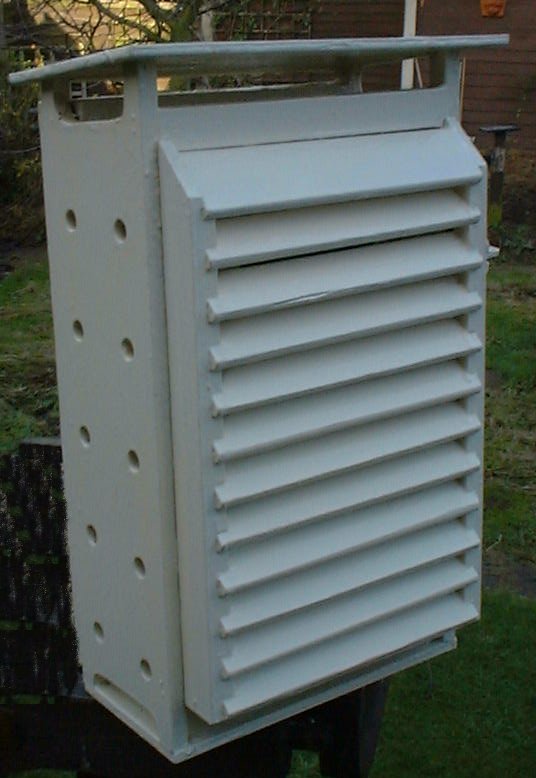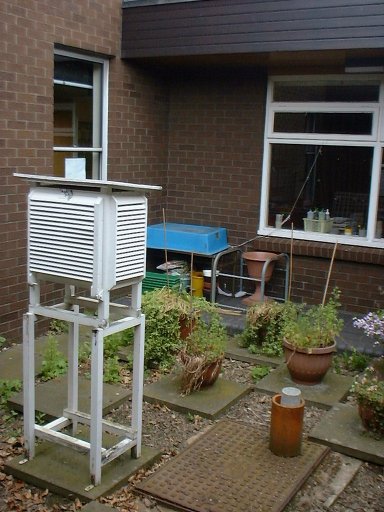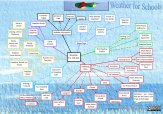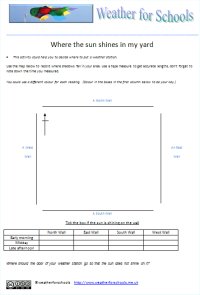Setting up Your Weather Station
Setting up your weather station can be a daunting task. These hints may make the task easier. Read all of the sections listed on the right before starting to set up your weather station. Weather Boxes and Weather Apparatus provide ideas of what you need and how you can make your own weather box.
If you find out how things should be done properly, from this website, from other websites, and from good books, you should end up with a useful site. Remember to tell others about your site, then they will know where the data comes from, and anything that is not quite perfect about the site. You might also want to find out if there are any local groups who meet to discuss measuring the weather. One group you might consider is the Climatological Observers Link - COL.
To see more about where to put your weather station see More About Setting up your Weather Station. This page will also show you where to put your weather vane.
The Stevenson ScreenThe Stevenson screen was invented by Thomas Stevenson (the father of the famous author of Kidnapped). Its main purpose is to allow the cold and warmth of the temperature to penetrate whilst preventing direct sunshine, wind or rain. This is done by having angled slats around the sides, and a double roof. It is painted white so that it reflects the direct heat of the sun. Readings should always be taken in the shade. This is why we use a special box to store the instruments. |
|
LocationThe ideal location is one where the distance
from any object is 2.5 to 3 x the height of the nearest tree
or building. This means that the trees or buildings will not
act
as a shield, making the measurements unrepresentative. This
is the same for the Stevenson screen and the rain gauge. Bearing
in mind other factors (see above) some compromise may have
to be achieved. In the photograph on the right this was the best
location that could be used in the school. |
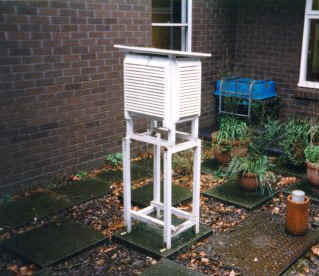 |
Height of the Stevenson ScreenThe stand of the Stevenson screen should be set in the ground so that the bulbs of the thermometers are at approximately 1.2m (120cm) above the ground. |
|
Underneath the Stevenson ScreenThe surface under the Stevenson screen should reflect the local environment. As grass is the norm in the UK most of the weather boxes here are on and surrounded by grass. However if the norm is bare earth, then bare earth should be under the Stevenson screen. |
|
SecurityIt is better to compromise the quality of the weather data collected than risk the damage of equipment by unwelcome visitors. One of the best places in schools is in a courtyard within the school buildings. This affords some protection from outsiders. Some weather instruments can be quite expensive and need to be kept secure. You may want to put a padlock on the Stevenson screen door to stop anybody resetting the instruments or tampering with them. |
|
Using the Stevenson ScreenThe door of the screen should face north so that when it is opened the sun does
not shine directly on the instruments. (This relates to weather
stations in the northern hemisphere. Reverse it for the southern
hemisphere.) |
|
MaintenanceThe water reservoir on the wet and dry thermometers needs to be kept topped up.
The indicating liquid in the thermometers needs to be monitored,
in case it becomes separated. If this happens you will see a gap somewhere
in the liquid in the glass tube. |
|
General NotesIn educational establishments a system needs to be set in place whereby only teachers and pupils under supervision
are allowed access to the weather station. This is to prevent
interference in the form of emptying or filling rain gauges,
resetting maximum
and minimum thermometers and general damage. |
